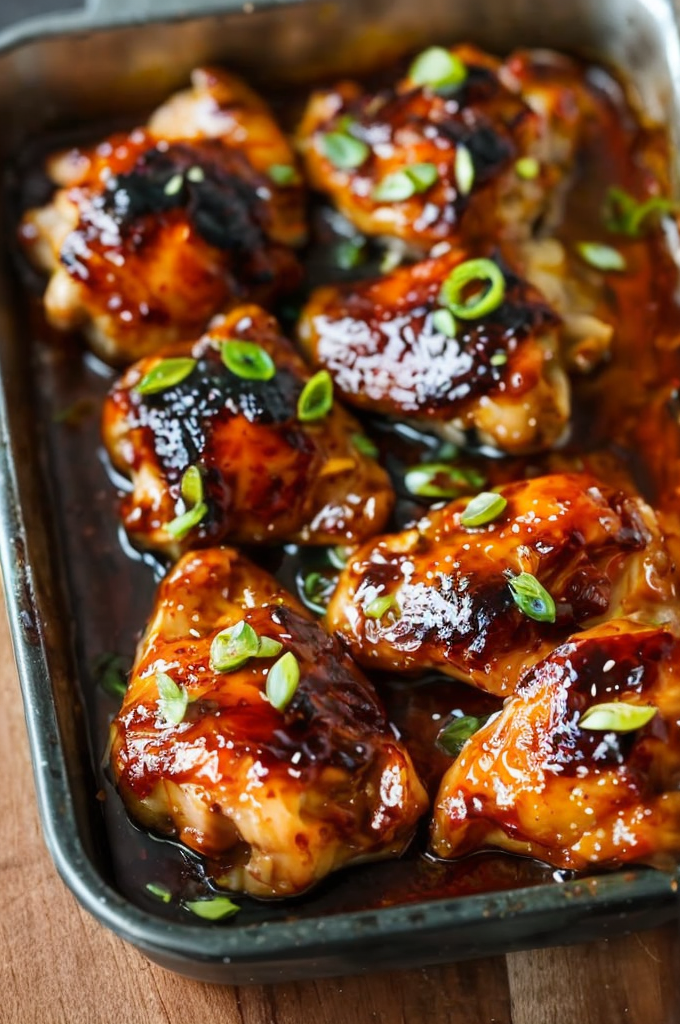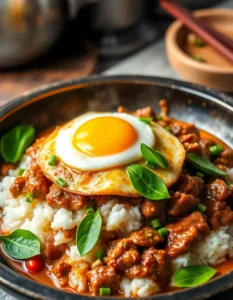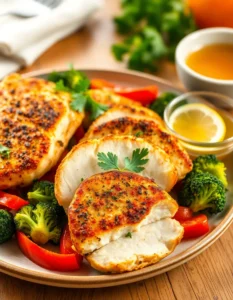Baked Teriyaki Chicken: A Flavorful Journey into Asian Inspired Cuisine
Imagine sinking your teeth into a piece of tender, juicy Baked Teriyaki Chicken. The savory glaze with hints of sweet and tangy undertones dances across your taste buds, offering a perfect balance of flavors that is both satisfying and irresistible. With its glossy finish and aromatic appeal, this dish not only satisfies the hunger but also provides a feast for the senses. A favorite in Asian cuisine, teriyaki chicken’s appeal lies in its simplicity and profound taste, making it a perfect meal for both weekdays and special occasions.
Quick Recipe Highlights
- Flavor Profile: Sweet, savory, and slightly tangy, with umami notes from the soy sauce and garlic enhancing every bite.
- Texture: Perfectly baked chicken retains juiciness, complemented by a sticky glaze that clings to its surface, ensuring a delightful mouthfeel.
- Aroma: Inviting scents of ginger and garlic waft through the air as the dish bakes, heightened by the toasty sweetness of sesame seeds.
- Visual Appeal: Deep amber glaze gives the dish a radiant shine, with vibrant garnishes adding pops of color.
- Skill Level Needed: Basic baking skills and sauce-making; the process is straightforward, ideal for all home cooks.
- Special Equipment: A baking dish, mixing bowl, and whisk are all that’s required to bring this dish together.
Recipe Overview
- Difficulty Level: Selected as easy due to the simple, step-by-step preparation and common kitchen tools required, making it accessible to novice cooks.
- Category: This dish perfectly fits into main courses for lunch or dinner, providing a hearty option that complements various side dishes.
- Cuisine: Rooted in Japanese culinary tradition, the dish showcases the versatility and widespread appeal of teriyaki style in global cuisines.
- Cost: Moderate, as it primarily involves pantry staples like soy sauce and garlic, with chicken being the main protein source.
- Season: Although enjoyable year-round, the warmth and richness of teriyaki chicken make it especially cherished during cooler months.
- Occasion: Suitable for casual family meals or festive gatherings, delivering impressive flavors with minimal effort.
Why You’ll Love This Recipe
Experience the irresistible taste and texture appeal of Baked Teriyaki Chicken. The robust flavors come together harmoniously, offering a delightful balance between sweet and savory. Each bite of the succulent chicken, enveloped in its flavorful glaze, provides a satisfying culinary experience you’ll crave repeatedly.
Convenience is another reason to embrace this recipe. With a prep time of just 15 minutes, this dish fits perfectly into your busy schedule. Its straightforward cooking process ensures a stress-free experience, allowing you to prepare a delicious homemade meal without spending hours in the kitchen.
Noteworthy are the nutritional benefits inherent in this dish. Chicken offers lean protein, crucial for muscle development, while the teriyaki sauce provides antioxidants with its ginger and garlic components. This makes it a health-conscious choice for nourishing family meals.
This dish’s social value adds to its appeal. Ideal for entertaining, Baked Teriyaki Chicken impresses guests with its flavor complexity and visual flair. Its complementing garnishes and sides create a beautiful presentation perfect for dinner parties or casual get-togethers.
Moreover, cost-effectiveness makes this recipe a staple in family dining. Utilizing budget-friendly ingredients, it offers a mouth-watering meal that doesn’t strain the wallet, proving that you don’t have to compromise on taste for affordability.
Historical Background and Cultural Significance
The origin story of teriyaki is rooted in Japanese culinary tradition. This cooking technique, which involves grilling or broiling food with a glaze of soy sauce, mirin, and sugar, has been cherished in Japan for centuries. “Teriyaki,” meaning “glossy grilled,” perfectly describes the lustrous appearance of the dish.
Cultural importance lies in its sociability; teriyaki is a communal meal often enjoyed in gatherings. It represents the fusion of flavor and technique, allowing diners to savor the harmony of simple ingredients transformed through skilled preparation and cooking.
Over time, the recipe has evolved. While traditional versions maintain the simplicity of three key sauce ingredients, western adaptations incorporate diverse elements, expanding the teriyaki profile. This evolution indicates a global fusion where teriyaki finds appreciation across borders.
Regional variations abound as teriyaki proliferates globally. In America, you’ll find it thickened with cornstarch, while in Hawaii, pineapple juice may add tropical flair. These variations exemplify its adaptability across different tastes and international culinary cultures.
Ingredient Deep Dive
Soy sauce is central to teriyaki’s signature umami flavor. As a staple in Asian cooking, its history spans over two millennia, connecting cultures through its fermented savoriness. Nutritionally, soy sauce adds depth with low calories, a touch of sodium, and rich umami compounds.
Ginger offers aromatic warmth and health benefits. Known for its anti-inflammatory properties, ginger elevates the teriyaki’s flavor complexity. Fresh ginger is best stored in a cool, dry place, while powdered varieties offer a dry alternative when fresh is unavailable.
Garlic infuses the dish with aromatic richness and a hint of pungency. Rich in vitamins C and B6, garlic adds an antioxidant boost to the sauce mix. Whole bulbs keep well in a dry environment; when purchasing, look for firm cloves not sprouting.
Honey contributes natural sweetness in many western adaptations, offering a healthier sugar alternative. Its select use provides flavor depth and viscosity, ensuring the glaze clings well to the chicken. Store honey at room temperature for the ideal consistency, and substitute with maple syrup if desired.
Common Mistakes to Avoid
- Over-marinating: Allowing chicken to sit in sauce too long can cause protein breakdown, leading to mushy texture. Limit marination to one hour for best results.
- Incorrect sauce consistency: A runny sauce doesn’t adhere well. Thicken by simmering longer or using a cornstarch slurry for ideal stickiness.
- High oven temperatures: Risk of burning glaze before chicken cooks through. Stick to moderate heat for even cooking.
- Skipping sugar: Essential for caramelization in traditional teriyaki. Opt for a sugar substitute if necessary but avoid elimination.
- Ignoring resting time: Let chicken rest post-cooking to maintain juiciness and allow flavors to meld.
- Uneven chicken pieces: Inconsistent sizes lead to disparate cooking times. Ensure uniform cuts for evenly cooked portions.
- Insufficient sauce coverage: Ensure all chicken pieces are well-coated to achieve uniform flavor.
- Nutrient robbing: Long high-temperature exposure can degrade garlic’s health benefits; incorporate raw elements if possible.
- Neglecting cleanliness: Sticky sauces demand thorough cleanup; prepare work surfaces and sink for efficient tidying.
- Wrong equipment: A shallow baking dish can overflow sauce. Choose appropriately sized cookware to contain excess.
Essential Techniques
Marinade absorption is crucial for the chicken to fully embody the teriyaki flavors. A few light knife scores across the meat help the marinade penetrate deeply, resulting in every bite being equally flavorful. Avoiding this step can lead to unevenly seasoned chicken.
Baking over grilling ensures even cooking, crucial for lean chicken breast often used in this dish. Preheat your oven thoroughly for uniform heat distribution, and place the chicken on a foil-lined baking sheet to prevent sticking and ensure hassle-free cleanup.
Balancing the teriyaki sauce involves achieving the perfect sweet-savory equilibrium. Monitor sugar content as excess can lead to overwhelming sweetness; taste the sauce as it reduces and adjust with more soy sauce or tangy elements to refine the balance.
Pro Tips for Perfect Baked Teriyaki Chicken
For the perfect marinade, combine equal parts of soy sauce, mirin, and sake to mimic authentic teriyaki flavors. This classic combination delivers just the right level of sweetness and umami, essential for achieving a traditional taste.
Allowing the chicken to rest at room temperature before baking ensures even cooking. Cold chicken straight from the refrigerator can result in unevenly cooked portions, while resting helps the meat achieve uniform temperature throughout.
Use freshly grated ginger and minced garlic instead of powdered spices. Fresh ingredients deliver a more vibrant flavor profile and enhance the aromatic qualities of the dish, making the effort worthwhile.
To avoid a too-runny sauce, reduce it over low heat until it coats the back of a spoon. This ensures the sauce blankets the chicken beautifully, enhancing both flavor and presentation.
Incorporate a touch of sesame oil in the marinade for added depth. Sesasme oil provides a nuttiness that complements the sweetness of the teriyaki sauce and elevates the recipe’s overall flavor complexity.
Garnish with scallions and sesame seeds for a pop of color and added texture. This simple step adds visual interest and a subtle crunch, rounding out the sensory experience of enjoying Baked Teriyaki Chicken.
Variations and Adaptations
Regional variations abound, each bringing unique influences to the classic teriyaki recipe. For a Hawaiian twist, incorporate pineapple juice to add a fruity note to your marinade, offering a sweet contrast to the savory elements.
Seasonal adaptations can adjust the flavor profile; try adding zest from fresh citrus during winter months for brightness or opt for light, herby marinades in the summer to reflect seasonal tastes.
For those with dietary restrictions, gluten-free soy sauce is available. This allows individuals with gluten sensitivities to enjoy teriyaki dishes without compromising on flavor. Balance with naturally gluten-free ingredients, ensuring the dish remains authentic.
Enhance the flavor by adding additional aromatic spices to the marinade, such as star anise or orange peel, which provide an exotic twist to the traditional teriyaki profile. This experimentation can create intriguing variations with familiar global influences.
Different textures can be achieved by using thighs instead of breasts, resulting in a richer mouthfeel. These variations cater to preference, appealing to diverse palates within your dining table.
Take your presentation to the next level by serving the chicken over a bed of spiralized vegetables or alongside vibrant stir-fried bok choy and bell peppers. These additions provide color contrast and nutritional value.
Serving and Presentation Guide
Mastering plating techniques will elevate your baked teriyaki chicken. Slice the chicken breast diagonally before arrangement, showcasing the juicy interior and allowing sauce to flow elegantly across the slices.
Garnish your plate with sesame seeds and chopped green onions; their simplicity adds elegance and complements the teriyaki’s flavors. For color contrast, a sprig of cilantro or a few radish slices enhance the visual appeal further.
Serve traditional accompaniments such as steamed white rice or sticky rice. These options soak up any extra sauce, marrying flavors beautifully. Exploring modern alternatives like quinoa or wild rice provides a nutty counterbalance.
Temperature considerations extend to serving hot, immediately after resting, to preserve texture and flavor. Room temperature chicken will not have the same aromatic lift, diminishing the sensory appeal.
Control portions effectively by suggesting slices per serving; this ensures balanced distribution, especially for gatherings where demand might exceed supply.
Wine and Beverage Pairing
Pairing the Baked Teriyaki Chicken with wines requires thoughtful selection to complement the dish’s rich flavors. A lightly chilled Pinot Noir or Merlot, with their modest tannin profiles, blend harmoniously with the sweet and savory teriyaki undertones.
Non-alcoholic alternatives, such as jasmine tea or ginger beer, offer refreshing contrasts to the chicken’s glaze, enhancing both refreshment and enjoyment without overwhelming the palate.
Coffee isn’t traditionally paired with teriyaki, but a light roast coffee served after the meal can cleanse the palate. Meanwhile, a delicate green tea offers a subtle astringency bringing harmony to post-meal sipping.
Temperature considerations for wine serve best around 12-15°C for reds, enhancing the aromatics. For beer, consider delivering slightly colder to enhance the bubbly refreshment character.
Serving suggestions extend to using stemmed glasses for wine, ensuring a refined dining experience, while chilled tumblers for cold beverages keep things casual and approachable at dinner parties.
Storage and Shelf Life
Proper storage methods safeguard your baked teriyaki chicken’s freshness. Place leftovers in an airtight container to prevent moisture loss and store them in the refrigerator, which provides optimal conditions for up to three days.
Maintain temperature requirements, ensuring your refrigerator runs below 4°C to inhibit bacterial growth. Proteins, especially poultry, should remain within temperature-safe zones at all times.
Utilize BPA-free containers for storage, as they sustain flavor integrity and allow stacking, maximising your fridge’s space. Clearly label with storage dates for ongoing freshness monitoring.
Signs of spoilage include off odors, changes in texture, or unusual coloration, at which point consumption should be avoided. Trust your senses and prioritize safety.
Reheating instructions suggest using a low microwave power with turning intervals or gently warming on the stovetop in its sauce to avoid drying out the chicken.
Freezing is an option for longer shelf life; ensure sauce is separate to maintain its consistency. Thaw overnight in the fridge before reheating for quality preservation.
Make Ahead Strategies
Benefit from a well-structured prep timeline. Begin the night before, allowing time for marinating and ensuring flavors saturate the chicken. Separation from sauce before cooking ensures controlled glaze coverage.
Store marinated chicken and unused sauce separately in the fridge. This strategy extends freshness and minimizes risk of cross-contamination, maintaining high food safety standards.
Assess quality impacts by monitoring marinade time, noting that beyond 24 hours can alter texture unfavorably. Encase prep elements in refrigeration promptly after assembly to retain quality.
Reheating guidelines include basting with additional sauce to reintroduce moisture, crucial after refrigeration or chilling. This restores the glaze’s appeal and culinary dynamics.
Post-reheating, add fresh elements like newly chopped scallions just before serving. This refreshes presentation, reinvigorating the visual and flavor profiles for your guests.
Scaling Instructions
Halving the recipe accommodates smaller households or intimate dinners. Cut ingredients in equal ratios, maintaining sauce balance, crucial for flavor retention and proportion fidelity.
Doubling or tripling requires larger cookware to adapt to more substantial volumes. Oversized sheet pans or roasting pans allow even spacing, preventing crowded cooking environments and ensuring quality.
Equipment adjustments include using mixers or food processors to distribute marinade efficiently in bulk preparation. Uniform handling promotes consistent results across expanded batches.
Timing modifications involve monitoring the chicken closely, as larger batch cooking may require calibration. Adjust internal checks with a meat thermometer for precise completion.
Consider storage adjustments for bulk. Utilize wide containers for even marination or sauce cooling, preserving flavor integrity across meals managed over several servings.
Nutritional Deep Dive
Diving into the nutritional elements of baked teriyaki chicken uncovers a balanced macro profile. Lean protein from chicken supports muscle health, with moderate fats contributing to satiety without excessive calorie load.
Vital micronutrients found in ingredients like ginger and garlic provide anti-inflammatory benefits, while soy sauce offers essential amino acids, crucial for metabolic function, moderated by alternative low-sodium versions.
Consider health benefits manifesting from reduced sugar teriyaki variants; these adaptions maintain glucose levels favorable to dietary concerns, balancing indulgence with wellness.
Portion analysis ensures balanced caloric intake per serving, ideal for managing dietary plans. Serve the recipe accompanied by fresh vegetables for additional nutritional enhancements.
Weight management is achievable; the lean protein content supports muscle maintenance, delivered here with a depth of flavor often absent in calorie-conscious dishes, making healthy eating both delicious and rewarding.
Dietary Adaptations
For those requiring gluten-free options, substitute traditional soy sauce for tamari. This modification maintains the dish’s signature umami, providing allergy-conscious diners a safe and flavorful experience.
Achieve a dairy-free rendition by focusing solely on the marinade’s natural richness. The absence of cream-based components keeps the dish light, ideal for those sensitive to lactose.
Explore vegan adaptations using firm tofu or tempeh as protein base substitutes. These options absorb marinade flavors well when pressed and prepared correctly, introducing plant-based enthusiasts to the joys of teriyaki.
Low-carb considerations may include opting for zucchinis or spiralized vegetables to replace rice, retaining the dish’s essence while accommodating carb-restrictive diets transparently.
Keto adaptations benefit from substituting sugar with non-glycemic sweeteners like erythritol or stevia. These offer sweetness necessary for authenticity without impacting ketosis.
Paleo enthusiasts will enjoy omitting soy products, instead creating coconut aminos-based sauces for flavor similar to soy while aligning with paleolithic dietary choices, ensuring adherence to guidelines.
Low-FODMAP modifications, replacing garlic with infused oils, provide a gut-friendly alternative, ensuring ease of digestion without sacrificing on listed merits found in the recipe.
The Recipe
Baked Teriyaki Chicken
Serves: 4
Prep Time: 15 mins
Cook Time: 30 mins
Total Time: 45 mins
Kitchen Equipment Needed
- Baking dish
- Mixing bowl
- Whisk
- Oven
Ingredients
- 4 boneless, skinless chicken breasts
- ½ cup soy sauce
- ½ cup water
- ¼ cup brown sugar
- 2 tablespoons honey
- 1 tablespoon freshly grated ginger
- 2 cloves garlic, minced
- 2 teaspoons sesame oil
- 1 tablespoon cornstarch
- 2 tablespoons water (for cornstarch slurry)
- Sesame seeds and chopped scallions for garnish
Directions
- Preheat your oven to 400°F (200°C). Prepare a baking dish by lightly greasing it or lining it with foil.
- In a mixing bowl, whisk together soy sauce, water, brown sugar, honey, ginger, garlic, and sesame oil.
- Place chicken breasts in the baking dish and pour the teriyaki mixture over them. Allow them to marinate for at least 15 minutes.
- Bake the chicken in the preheated oven for 25-30 minutes, or until fully cooked and the internal temperature reaches 165°F (75°C).
- Remove chicken from the oven and transfer to a serving platter. Let it rest for a few minutes.
- Meanwhile, transfer the teriyaki sauce to a small saucepan. Bring to a simmer over medium heat.
- In a small bowl, mix the cornstarch with water to form a slurry. Stir it into the simmering sauce to thicken, cooking for another 1-2 minutes.
- Pour the thickened sauce over the baked chicken and garnish with sesame seeds and chopped scallions before serving.
Recipe Notes
- For more flavor, marinate the chicken for up to 1 hour in the refrigerator before baking.
- Swap chicken breasts for thighs if preferred, adjusting cooking time as needed.
- Feel free to adjust the sweetness by altering honey and sugar proportions to taste.
Troubleshooting Guide
Troubleshoot texture issues by ensuring the chicken is adequately dried before baking. Excess moisture can result in a less crisp finish. Use paper towels to pat the chicken dry.
Balance flavor by adjusting sweetness and salt levels; adding soy sauce incrementally to taste is safe, as rectifying is more manageable than reducing excess.
Manage equipment challenges by ensuring the oven is preheated; skipped preheating can lead to longer cooking times and inconsistent cooking.
For ingredient substitutions, seek similar profiles. Coconut aminos for soy sauce offer lower sodium and add sweetness, though slightly altering the fundamental taste.
Troubleshoot timing concerns by using a meat thermometer; internal chicken temperatures of 165°F (75°C) ensure safe consumption without guesswork.
Recipe Success Stories
Delve into community success with Baked Teriyaki Chicken, where readers have offered glowing feedback following recipe intents and adaptations. Fathers have bonded with children over cooking this modern classic, entrenching familial ties through shared experience.
Creative variations offer adaptation successes, with substitutions like lime for lemon providing zesty alternatives. Reader suggestions continuously enhance this cherished recipe collection, bringing it dynamically into modern kitchens.
Photography tips offer visual enhancement; experimenting with natural lighting creates stunning dish visuals, encouraging others to share their delights on social platforms like Instagram or Pinterest.
Frequently Asked Questions
Can I use thigh meat instead of breasts?
Absolutely, chicken thighs offer a richer texture and remain more succulent, suiting a variety of taste preferences. Adjust cooking time as thighs often cook quicker.
What’s the best way to thicken teriyaki sauce?
Cornstarch slurry is highly effective; simply mix cornstarch with an equal amount of cold water and whisk into your sauce over heat until it achieves the consistency you desire.
How can I reduce the sodium content?
Select low-sodium soy sauce alternatives or replace traditional soy with tamari, offering a gluten-free and less salty substitute.
Can I prepare this recipe ahead of time?
Yes, marinate the chicken overnight if desired, and refrigerate the prepared sauce separately. Reassemble and bake when ready to serve for maintaining freshness.
What sides pair well with teriyaki chicken?
Traditional sides like sticky rice or steamed vegetables are excellent choices, but consider modern options like quinoa for a health-forward pairing.
Can this dish be frozen?
While best fresh, the chicken freezes well. Store sauce separately and ensure it’s reheated gently to maintain flavor.
How do I avoid burning the sauce?
Reduce sugar if needed, and ensure oven cleanliness to prevent excessive caramelization, risking scorch marks.
Does wine pair well with teriyaki?
Yes, light red wines complement the dish, balancing sweetness while offering an elegant dining experience. Pair wisely for enhanced enjoyment.
Is there a vegetarian version?
Indeed, replace chicken with firm tofu or tempeh, keeping the cooking process intact while ensuring robust marinade absorption.
What can I do with leftovers?
Slice cold chicken over salad or within wraps for next-day meals. The sauce doubles as a delightful salad dressing or stir fry base.
Additional Resources
Explore related recipes that complement Baked Teriyaki Chicken for inspiration, like miso soup starters or seaweed salad companions vital for balanced dining experiences.
Technique guides found online are invaluable, detailing how to achieve perfect rice accompaniments or demonstrating knife skills that elevate food prep confidence.
Ingredient information provides background richness; resources educate on soy sauce origins or ginger’s medicinal properties, deepening comprehension and appreciation for culinary elements.
Recommendations for equipment upgrade basic kitchens into professional environments; from bamboo whisks to ceramic grinders, learn what enhances both preparation and presentation.
Seasonal variations provide ongoing dietary inspiration; family menu planning becomes a joyful task incorporating the colorful ebbs and flows of seasonal produce.
Join the Conversation
Participate by sharing your Baked Teriyaki Chicken interpretations via social media channels. Engage with a community of food enthusiasts seeking new techniques, gaining feedback and inspiration.
Photography tips abound; capture the dish’s essence by experimenting with angles and settings, inviting viewers into your culinary experiences through authenticity and flair.
Encourage authentic discussions by providing recipe reviews and constructive suggestions. Your input refines collective comprehension, improving overall kitchen confidence for readers alike.
Community engagement fosters connection through shared interests; from swapping recipes to suggesting wine pairings, collective wisdom amplifies individual effort into broader food enjoyment.
Explore this realm proactively, inviting collaboration to enhance culinary understanding and recipe expansion. Weave personal narratives into shared ones, enriching community fabric through mutual interests and respect.



